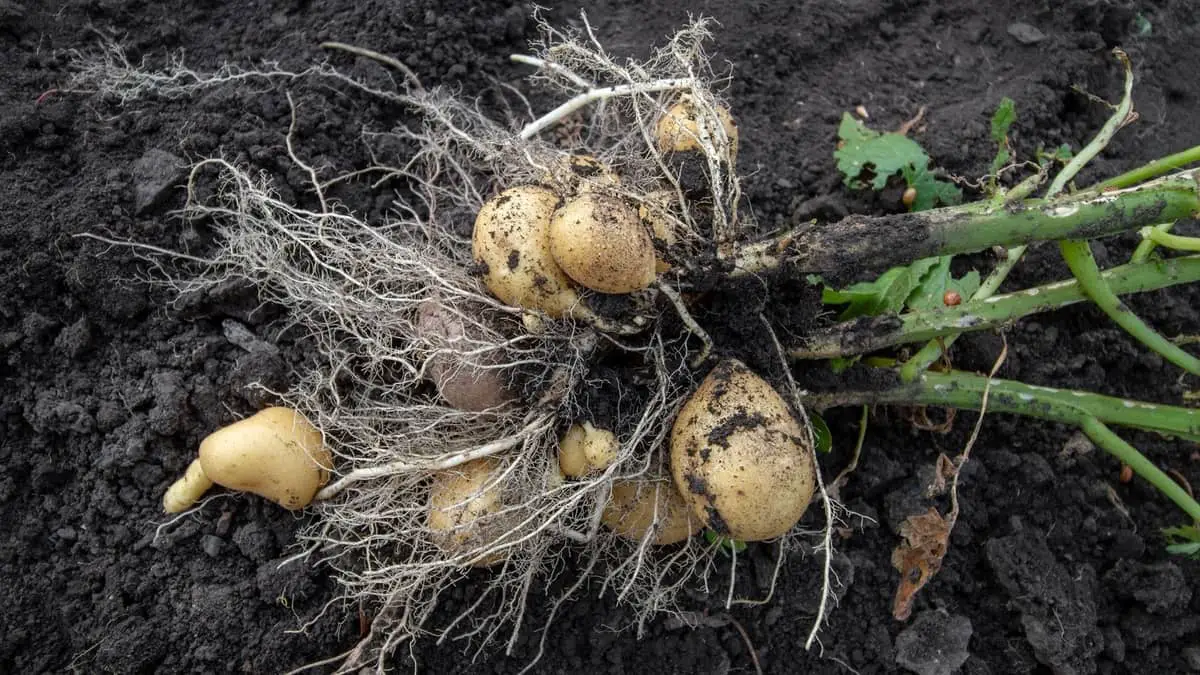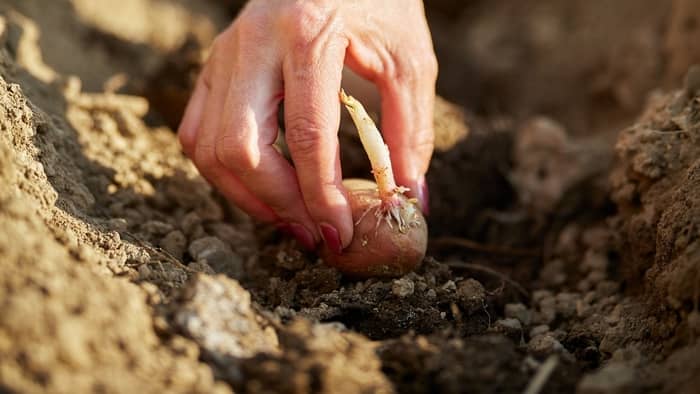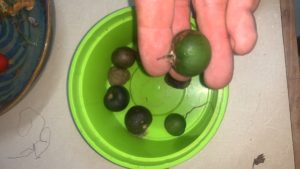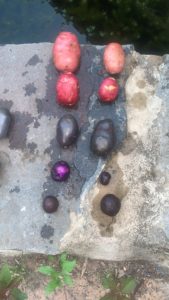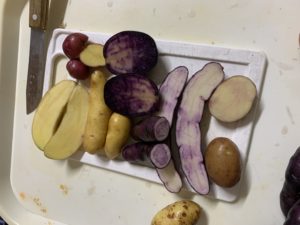Last Updated on May 30, 2022 by Marco C.
Let’s take a look at stem tubers. As far as examples of stem tubers go, nothing compares to the delicious humble potato! But there are many others, and these stem tubers are an integral part of our diet conferring joy and health to our meals.
What Are Tubers?
Tubers are large storage organs that plants use to store water and nutrients for times when conditions are not favorable. Broadly speaking we get stem tubers and root tubers. Stem tubers are basically enlarged stems that grow just below the surface of the soil. These allow the storage of nutrients and water – and being stems, they can shoot new leaves and branches should they need to. Root tubers are enlarged roots and store nutrients underground. This article deals with stem tubers.
Learn more about: Is A Potato A Tuber? Get To Know The Facts
A Closer Look At Stem Tubers Before We Get Into Examples Of Stem Tubers.
A stem tuber is an enlarged stem. These are often a bit squat and fat and tend to store water, starch, and sometimes sugar. If we look at any stem, it has places where leaves grow out, and next to these places, we have bud nodes that can give rise to a growth shoot. Because it is a stem tuber, these bud nodes are all over the length of the stem and can give rise to a growth shoot with leaves. If we look at a root tuber, such as a carrot – there is only one bud node at the end of the carrot, where the leaves grow. All the other places things can grow will only yield roots.
Examples Of Stem Tubers: 1 The Potato
This is an incredibly important food source to humanity and one of the best examples of stem tubers. Many people think that a potato is a seed – this is because you buy “seed potatoes” and plant them and potatoes grow. A seed potato is in fact just a stem tuber. When you plant a potato you are really just planting a stem tuber and it shoots.
A potato tuber when planted will “chit” and produce small shoots that will then push through the soil and grow. The plant produces energy and uses this to produce more potato tubers underground. As the plant ends its growth cycle it will produce flowers, and these flowers produce fruit that looks like tomatoes.
If you take these fruits, place them in a jar, and allow them to rot they will then activate the seeds. If you grow the seeds they will produce plants that will produce potatoes – but here is the catch – the potatoes will look nothing like the parent potato stem tuber! Each potato grown from seed is an entirely new unique potato and will be a different shape, color, size, and taste to the parent from which the seeds came!
Growing Fungus Resistant Unique Potatoes
I have a personal love of the amazing examples of stem tubers that my growing potatoes from seed provide. In my area, there are a few fungal blight problems that flare up from time to time. Conventional wisdom is that if you get blight you must remove blighted material, not grow potatoes in that soil for seven years and spray any other potatoes you grow nearby with systemic fungicides. This is silly.
I take any potato plant that has been killed by blight and I make compost with it. I mix this with a bit of additional compost and aged manure. I then take potato cherries and ferment them to activate the seeds. These seeds are then germinated in the blight compost – naturally, any seed which has genes that make it blight sensitive will not produce a baby potato! If you then take this baby potato and propagate it in a small pot it will produce three or four “seed” potatoes the size of marbles. In the next cycle, you can get these to the golf ball size of proper seed potatoes, and the next cycle is a full production of large meaty unique potatoes.
Potato cherries look a bit like tomatoes. They are filled with little black seeds and form on the end of potato stems after the plant flowers.
In this way, I have bred my own largely blight-resistant potatoes. Some of these are purple. Some are red. Some are pink with red spots. Some are yellow and banana-shaped. Some are purple or black and look like dog turds. These potatoes are just a lot of fun and they are fungal disease resistant.
A few of the potatoes I have bred over the years. This is a very broad mixture of potato genetics and each year I breed a few more unique potatoes that become part of our garden’s magic! These potatoes are unique and taste better than anything you can buy in the shop.
Examples Of Stem Tubers: 2 The Yam/Madumbe
This plant is one of my favorite examples of stem tubers because it is incredibly useful. Just like a potato, the stem tubers are delicious. Now the big difference between a madumbe compared to a potato is that their leaves are edible too! Not all yam leaves are edible – check with your root provider to find out if the variety you procure has edible leaves.
These are tough plants. They grow in wet boggy areas and are beautiful to look at. Some have a variegated leaf, others a normal leaf. The root tubers store well. My favorite thing to do with these is to peel them and roast them like I would a potato. You can halve the number you prepare as these things are really filling. For ladies who are approaching their period, eating madumbes in the last few days stops stomach cramps and gas problems.
A few sad madumbe yam plants growing near my front door. These are beautiful in summer, but as temperatures drop they become a bit less beautiful. In spring they will be back.
No: Ginger and Sweet Potatoes Are Not Stem Tubers
You will find some people referring to ginger and sweet potatoes as examples of stem tubers. These are rhizomes and root tubers respectively. These are minute little details that botanists argue about – and do not let these facts detract from your enjoyment of gardening.
Whether a sweet potato or ginger root is an example of a stem tuber or not, this does not mean that you should not grow these awesome root tubers and rhizomes respectively. Sweet potatoes, like yams, have incredibly nutritious leaves that have incredible health benefits.
I hope you have enjoyed exploring these examples of stem tubers. The types of tubers out there are tangled up in a lot of semantics, and it really does not matter what you call them. They taste good! I love my potatoes and I hope this article inspires you to go out, grow some potato stem tubers from seed potatoes and then let the plants form potato cherry (fruits) harvest the seeds, and grow your own unique potatoes from these! Share this article if you enjoyed it.
Read more about: Is Potato A Root Vegetable Or Not? Deep Analysis On The Potato Plant
FAQs
Do stem tubers grow above ground?
They can, but this is not desirable. These have generally evolved to be underground structures. Potatoes for example, if they form above ground stem tubers will accumulate toxic compounds in these tubers that are not present in underground tubers. This is why we do not eat green potatoes.
What is the tuber of a plant?
A plant that develps tubers produces large swollen underground storage structures. These can be stem or root tubers.
What are stem tubers?
Stem tubers enable a plant to store nutrients, energy and water below the surface of the soil in a swollen stem. Stem tubers have nodes that can develop shoots.
Dr. Garth A. Cambray is a Canadian/South African entrepreneur and beekeeper with 28 years of experience in apiculture and specializes in adding value to honey. His Ph.D. research developed a new advanced continuous fermentation method for making mead that has resulted in a number of companies globally being able to access markets for mead. His company, Makana Meadery, exports honey mead to the USA where it is available to discerning connoisseurs. He has also developed technologies to commercially manufacture organic honey vinegar in Zambia for export globally. He holds a few patents globally in the ethanol industry and believes in technology and knowledge transfer for human development and environmental sustainability. One of his proudest achievements is the fact that the wind farm he started at one of his old apiary sites has essentially made his hometown carbon neutral.

